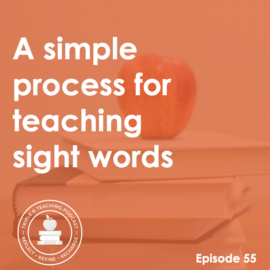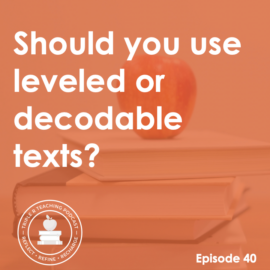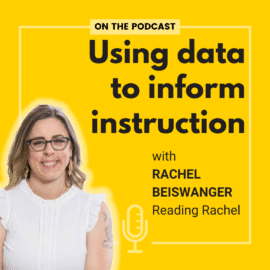
TRT Podcast #93: How to give corrective feedback
093: What’s the best response when students misread a word? How can our response be both efficient and helpful? Find out in today’s episode!
Listen to the episode here
Full episode transcript
Hello, I'm Anna Geiger from The Measured Mom, and today we are starting Episode 93 of the podcast. We're going to talk about how to give corrective feedback. This is part of our explicit instruction series.
Remember, explicit instruction is when you are very clear and direct about what you want your students to learn. There is no ambiguity; it's very clear and obvious. Giving good corrective feedback is part of explicit instruction. So let's talk about it using, again, as our guide, Anita Archer and Charles Hughes' book, "Explicit Instruction."
If your students have given the correct response, you can very quickly affirm it and move on, usually I say "excellent" or "good job." That's something we do naturally as teachers.
What gets to be a little harder is when students make mistakes and we're not sure exactly what to say. Let's say that your student is hesitant with the answer. For example, you give them a word to read and the word is "make," and they say, "make?" as kind of a question, they're not sure.
You could say, "Well, let's look at that word," and you do a little bit of reteaching. You say, "Remember, when we have a vowel and a consonant and an E at the end, the E makes that vowel say its long sound. So, I would read this word like this, make. Now you read it, make."
So you see that there's a little bit of reteaching. It was very, very quick, but we look for opportunities to do that.
Let's say you're doing a blending drill and you have the word "rain," and some of your students say, "ran." That would be another time where you could give some reteaching. You could put the word "rain" on the board, underline the letters AI and say, "What sound do the letters AI represent? /ā/. That's right. So let's read the word together." Then you point to each grapheme as you read, "/r/ /ā/ /n/, rain." Again, a quick reteaching in the case of student error.
If a student is reading orally to you, and you're not doing an assessment, so let's say you're just listening to them read and they make an error on a word, what you're going to want to do is have them reread the word and then read the whole sentence.
I watched a webinar about this which was extremely helpful. It was with Margaret Goldberg, and she's one of my favorite people. In her webinar with Collaborative Classroom, here are the steps that she said to think about when a student stumbles on a word: First you just stop and listen, and you maybe say something about the error. You might say, "Oh, careful! Reread. Sound that word out," and you listen to what they say.
After that, you provide the appropriate corrective feedback. If you're wondering what that feedback should be, here are some things to think about. What did they say? What part of the word did they miss? Why? Then provide the appropriate feedback.
Let's say they're reading the word "plant" and they read "pant." Okay, so clearly the issue there is they're not reading both letters in the blend. So, you could say, "Careful, try that again."
If they still say "pant," you would point to the beginning of the word and you would say, "I see two letters at the beginning here that spell two sounds." You point to each letter as you go, "/p/ /l/ /ă/ /n/ /t/. Say the sounds as I point to the letters, /p/ /l/ /ă/ /n/ /t/. What's the word?" They say it, and then you say, "Now go back and read the sentence again."
Now, let's say the word includes a phonics pattern you haven't taught yet, but occasionally those words do come up in their reading, right? Let's say the word is "made" and they haven't learned silent E. You would just say, "That word is made. What's the word? Made. Now reread the sentence." So, you just tell them the word. If you think it's something they can learn and you can pre-teach it, go right ahead. But for many kids, just having you tell them the word will be the most efficient way to work through the text.
Now, let's say they're not actually reading to you, but they're answering a question. So you've read a story together - maybe you've read it to them, or they've read a decodable text or a more advanced text to you - and they answer a question incorrectly.
You might say, "What is the problem of the story?" and they're just not getting it. One thing you could do is ask lower level questions to get them to the higher question.
Let's use an example we're all familiar with, The Billy Goats Gruff. You could say, "What is the problem of the story?" and they're not quite sure how to answer it.
You could say, "Well, let's think about this for a little bit. Who are the main characters in our story? That's right, the three billy goats. What do they want to do? Yes, they want to cross the bridge, but why can't they? Right. The troll is in the way. So, what is the problem the goats are having? That's right. The problem of the story is the goats want to cross the bridge, but the troll won't let them."
I want to close this up with a nice summary paragraph in the Explicit Instruction book. It says, "In summary, good corrections are consistently and immediately provided, match the type of error made by the student, are specific in the information they convey, and focus on the correct response. In addition, corrections are delivered in an encouraging tone and end with the correct response."
We don't want to play a guessing game with figuring out the correct answer. We want to quickly and efficiently show them how to get to that answer.
You can find the show notes for this episode at themeasuredmom.com/episode93. Talk to you next time!
Sign up to receive email updates
Enter your name and email address below and I'll send you periodic updates about the podcast.
Related links
- Explicit Instruction, by Anita L. Archer and Charles A. Hughes
- Why Explicit Instruction? video with Anita Archer on Center for Dyslexia MTSU
- What should we do when a reader stumbles on a word? blog post by Margaret Goldberg







Leave a Comment